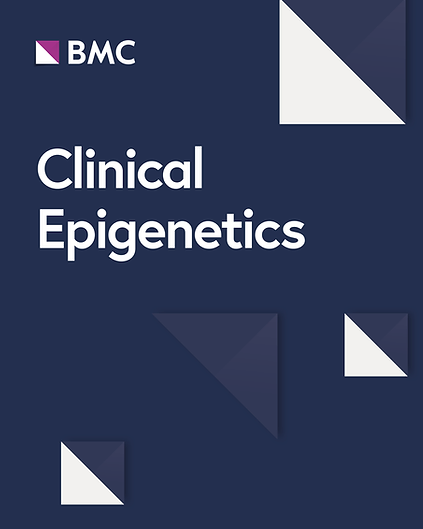An EWAS of dementia biomarkers and their associations with age, African ancestry, and PTSD
IF 4.4
2区 医学
Q1 GENETICS & HEREDITY
引用次数: 0
Abstract
Large-scale cohort and epidemiological studies suggest that PTSD confers risk for dementia in later life but the biological mechanisms underlying this association remain unknown. This study examined this question by assessing the influences of PTSD, APOE ε4 genotypes, DNA methylation, and other variables on the age- and dementia-associated biomarkers Aβ40, Aβ42, GFAP, NfL, and pTau-181 measured in plasma. Our primary hypothesis was that PTSD would be associated with elevated levels of these markers. Analyses were based on data from a PTSD-enriched cohort of 849 individuals. We began by performing factor analyses of the biomarkers, the results of which identified a two-factor solution. Drawing from the ATN research framework, we termed the first factor, defined by Aβ40 and Aβ42, “Factor A” and the second factor, defined by GFAP, NfL and pTau-181, “Factor TN.” Next, we performed epigenome-wide association analyses (EWAS) of the two-factor scores. Finally, using structural equation modeling (SEM), we evaluated (a) the influence of PTSD, age, APOE ε4 genotype and other covariates on levels of the ATN factors, and (b) tested the mediating influence of the EWAS-significant DNAm loci on these associations. The Factor A EWAS identified one significant locus, cg13053408, in FANCD2OS. The Factor TN analysis identified 3 EWAS-significant associations: cg26033520 near ASCC1, cg23156469 in FAM20B, and cg15356923 in FAM19A4. The SEM showed age to be related to both factors, more so with Factor TN (β = 0.581, p < 0.001) than Factor A (β = 0.330, p < 0.001). Genotype-determined African ancestry was associated with lower Factor A (β = 0.196, p < 0.001). Contrary to our primary hypothesis, we found a modest negative bivariate correlation between PTSD and the TN factor scores (r = − 0.133, p < 0.001) attributable primarily to reduced levels of GFAP (r = − 0.128, p < 0.001). This study identified novel epigenetic associations with ATN biomarkers and demonstrated robust age and ancestral associations that will be essential to consider in future efforts to develop the clinical applications of these tests. The association between PTSD and reduced GFAP, which has been reported previously, warrants further investigation.痴呆症生物标志物的 EWAS 及其与年龄、非洲血统和创伤后应激障碍的关系
大规模的队列研究和流行病学研究表明,创伤后应激障碍会带来晚年痴呆症的风险,但这种关联的生物机制仍然未知。本研究通过评估创伤后应激障碍、APOE ε4基因型、DNA甲基化和其他变量对血浆中与年龄和痴呆相关的生物标志物Aβ40、Aβ42、GFAP、NfL和pTau-181的影响来探讨这一问题。我们的主要假设是创伤后应激障碍与这些标志物水平的升高有关。分析基于一个由 849 人组成的创伤后应激障碍富集队列的数据。我们首先对生物标志物进行了因子分析,结果发现了一个双因子解决方案。借鉴 ATN 研究框架,我们将由 Aβ40 和 Aβ42 定义的第一个因子称为 "因子 A",将由 GFAP、NfL 和 pTau-181 定义的第二个因子称为 "因子 TN"。接下来,我们对双因子得分进行了表观基因组全关联分析(EWAS)。最后,通过结构方程建模(SEM),我们评估了(a)创伤后应激障碍、年龄、APOE ε4基因型和其他协变量对ATN因子水平的影响,以及(b)测试了EWAS显著DNAm位点对这些关联的中介影响。因子 A EWAS 发现了 FANCD2OS 中的一个显著位点 cg13053408。因子 TN 分析确定了 3 个 EWAS 重要关联:ASCC1 附近的 cg26033520、FAM20B 中的 cg23156469 和 FAM19A4 中的 cg15356923。SEM 显示年龄与两个因子都有关系,与因子 TN 的关系(β = 0.581,p < 0.001)比与因子 A 的关系(β = 0.330,p < 0.001)更密切。基因型决定的非洲血统与较低的因子 A 相关(β = 0.196,p < 0.001)。与我们的主要假设相反,我们发现创伤后应激障碍与 TN 因子得分(r = - 0.133,p < 0.001)之间存在适度的双变量负相关,这主要归因于 GFAP 水平的降低(r = - 0.128,p < 0.001)。这项研究发现了与 ATN 生物标志物相关的新的表观遗传学关联,并证明了强大的年龄和祖先关联,这对于今后开发这些测试的临床应用至关重要。创伤后应激障碍与 GFAP 减少之间的关联此前已有报道,值得进一步研究。
本文章由计算机程序翻译,如有差异,请以英文原文为准。
求助全文
约1分钟内获得全文
求助全文
来源期刊

Clinical Epigenetics
ONCOLOGY-
自引率
5.30%
发文量
150
期刊介绍:
Clinical Epigenetics, the official journal of the Clinical Epigenetics Society, is an open access, peer-reviewed journal that encompasses all aspects of epigenetic principles and mechanisms in relation to human disease, diagnosis and therapy. Clinical trials and research in disease model organisms are particularly welcome.
 求助内容:
求助内容: 应助结果提醒方式:
应助结果提醒方式:


